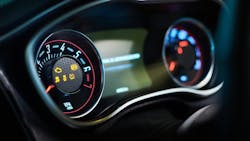Things that seem like common sense at a collision repair shop might not be so obvious to customers.
The employees of Paap Auto Body in Mattoon, Illinois, once found that lesson out the hard way. It is the shop’s standard practice that after things like blind spot monitors and intelligent cruise control are recalibrated, someone from the shop will have to drive the car about 20 miles to make sure everything is back to normal. But someone forgot to tell the customer that.
“The customer saw us with their car out on the interstate,” recalls shop owner Tim Paap. “We failed to tell them that we were taking their car for a test drive to make sure everything worked properly. Customer wasn't very happy.”
You only get one chance to make a first impression. That’s an old saying—but it’s one that any business owner would be wise to heed. For a collision repair shop, that first impression is the intake process. Sure, there may be initial conversations over the phone or messages exchanged via email, but it is when the customer is there in person to hand over the keys that the relationship really begins. And having a thorough, consistent intake process is key to that relationship starting smoothly.
Get Everything in Place
Gathering information is the first step in any intake process, and it starts with the first moment of customer outreach. The customer calls to schedule an appointment, and the Paap Auto Body team sends them a repair authorization form, which can be completed electronically. When the customer then brings their car in, the real information gathering begins.
The Paap team will go over the car with the customer, pointing out the damage to be fixed as well as any existing damage not part of the repair. They’ll do a pre-wash of the vehicle, including wheels and tires, and then take pictures. That’s all to ensure that nothing is missed.
“If some dirt or something was covering up some scratches, or something of that nature, we found it and we send those to the customers,” says Paap.
And while the information gathering is crucial, it is also important not to lose sight of the customer experience. Drivers experience an accident roughly once a decade, so they are often lost and looking for guidance and direction. Paap Auto Body sends all of its customer service representatives through a class Mike Anderson, owner of Collision Advice, offers on providing a great customer experience, which helps them treat customers with respect while also getting the information the business needs.
“Empathy, trust, and direction is kind of how we go through it,” Paap says. “Because a lot of (customers) are lost when they come in. And then they’re trying to listen to their insurance companies who have hired these people by phone interviews, and they don’t even know what they’re doing. So, we try to guide them in the right direction that we feel is best for them to go down the proper road to getting their car properly repaired.”
Put Pen to Paper
A key to the intake process in Paap’s mind is a form to capture all pertinent information that might not be immediately obvious in a repair. The Paap Auto Body intake form covers all basics such as contact info, insurance claim information, etc. But it also asks important questions like if the driver felt an impact from the crash, what the road conditions were, if the vehicle is equipped with any aftermarket parts, and more.
In modern vehicles, every detail matters. Even where passengers were seated in the vehicle and if they were wearing seat belts gives vital information for completing a safe repair. For example, the repair procedure for Hyundai calls for the replacement of all seat belts that were in use at the time of an accident, no questions asked. Anything that could be a factor in completing the repair belongs on the intake form.
“Also, the speed in which the car was going for the transfer of energy to the car,” Paap adds. “So, you kind of have a general idea of how fast the car was going, what direction, if there’s any ceramic coating or anything on the car, the speed if it was dry out, if they got spun out, or if they got shoved sideways. If they got shoved sideways, did that flat spot the tires? These are all questions on our intake form when a customer comes in.”
The intake form is a key piece of documentation along with clear and detailed photographs; Paap cites both as must-haves in any thorough intake process. With all that information in place, the vehicle gets pre-scanned in the same spot where it received its pre-repair wash. From there, it’s onto production.
Pay Attention to the Little Details
Cars, of course, feature more technology on board than ever before. While things like adaptive cruise control will be calibrated during the repair process, lower-tech conveniences are something that can be addressed while doing a vehicle intake. Think of things like the car’s compass pointing in the right direction or radio station presets going back to normal after removing a battery.
“Nissan, when you disconnect the battery, you need to go in there and reset all their HVAC settings, basically the driver side and passenger controls of the HVAC system,” Paap says. “So, you have to go in there and reinitialize all those things of that nature that we learn that are car-specific.”
And, don’t forget to let the customer know that this may all involve a test drive.
“If you see your car out on the interstate, or your friends see your car out on interstate, that’s what we’re doing with it.”
About the Author
Todd Kortemeier
Todd Kortemeier is former editor of FenderBender magazine and started writing as a contributor in 2024.
Sign up for our eNewsletters
Get the latest news and updates

